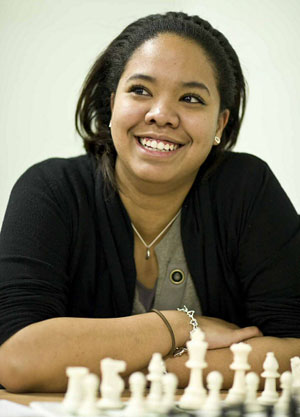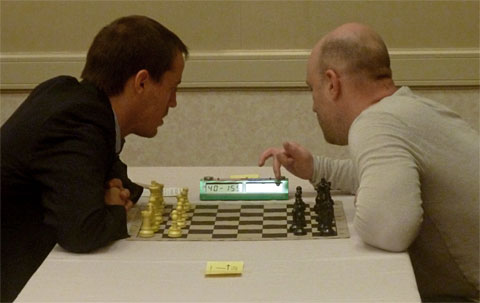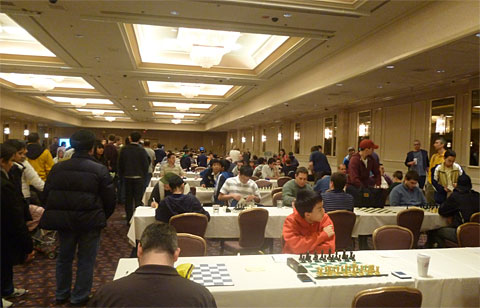Chevannes visits Chess America!

WFM Sabrina Chevannes of Birmingham, England penned an article for ChessBase about her American chess experience. Late last year, Sabrina told me she was coming to the U.S. for a visit. I had been covering her chess activities since she was around 13. Unfortunately, she would be too far away for an overdue face-to-face meeting, but unbeknownst to me she trekked to “Sin City” to check out the North American Open. Of course this is not considered the marquee tournament of the U.S., but it still draws a handful of top players on the American circuit and a few strong internationals.
Newlywed Varuzhan Akobian would be the highest-rated U.S. player at 2698 USCF and Alexander Shabalov at 2600 USCF seems to play in every single major tournament (hence his relatively low rating). Both were overshadowed by Francisco Vallejo-Pons who initially got hundred points added to his FIDE rating when he played in the 2010 World Open.
Chevannes’ article echoed the negative observations made by many European predecessors. Granted, these are complaints even made by U.S. players. The fact that one has to bring their own equipment to tournaments is well-known. It has been written about in many articles by those experiencing tournaments in the U.S. It is a truth that U.S. players have gotten used to, but on occasion we get to experience this amenity.
“All in all, my first impressions of a US tournament wasn’t great as it seemed like a very lazy and unprofessional way of running things, but the prize money was pretty decent for such a short tournament. The fact that it was held in the middle of the Las Vegas strip was a good and bad thing – good for the entertainment, bad for my wallet!”
Everyone chuckles at the thought of an organizer supplying equipment in the U.S. If that should happen, the poor chap would be replacing “missing” clocks every round. Nevertheless, players bring their clocks and have to play the “clock game” every round. I’ve seen top players sitting at an empty board waiting on a clock or set. Seeing playing fumbling with their clocks is common and 2700-rated players are no better at setting clocks than anyone else. In fact they may have less experience!

Sabrina caught this shot of Francisco Vallejo-Pons and Alexander Shabalov presumably checking the time-delay feature. Photo by Sabrina Chevannes.
The main complaint in U.S. tournament is one Chevannes also brought out… pairings. She was bemused at the do-it-yourself charts, but they are not really do-it-yourself. Players record the results and the tournament directors get them from one location instead of running around collecting scores. They end up having to do that anyway if someone does not record their scores. However, the practice of setting pairings out only minutes before the game is one that has dogged U.S. tournaments for decades. Her observations followed:
“Some boards were half set up, some boards weren’t even there, people were everywhere, just gathering and having a chat. It seemed that by arranging things in this manner, the organisers didn’t have any control over when the game could start.”

Yikes! Round starting late.
Photo by Sabrina Chevannes.
This is common because the pairings are sometimes up late and it takes ten minutes for people to get to their boards and set up. Then the dreaded pre-round announcements. Ideally, pairings are put up about 15 minutes before the round. Of course delays are inevitable amidst a host of unforeseen events… perhaps some Vegas-related. She summed up her experience this way:
All in all, my first impressions of a US tournament wasn’t great as it seemed like a very lazy and unprofessional way of running things, but the prize money was pretty decent for such a short tournament. The fact that it was held in the middle of the Las Vegas strip was a good and bad thing – good for the entertainment, bad for my wallet!
Alas… we’ve heard this before. I hope you enjoyed yourself Sabrina! 🙂

Originally posted on uschess.org
Fri Jan 13, 2012 12:11 am:
I find it curious that Sabrina Chevannes’ article (“Chess in the US in the eyes of the English”) has been given the attention it has and almost laughable that none of the commenters here, at chessbase.com, or the various online publications that have picked up the story (susanpolgar.blogspot.com, thechessdrum.net. etc.) have noted what I consider to be the key limitation of her review: while Ms. Chevannes did happen to be in Las Vegas at the site of the North American Open, she DID NOT PLAY in the event. Just as I would not recommend against a sound opening I had never tried, I would not negatively review a tournament I had not participated in, and especially not without disclosing that to the reader.
Apparently, Ms. Chevannes did play some tournament chess during her visit to the U.S., participating in the extremely-well-received Northern California International hosted by Arun Sharma and Ted Castro the following week (the organization of which addressed many of the issues she raises in her article, see: https://main.uschess.org/content/view/11556/654 and https://main.uschess.org/content/view/11563/654). It is unfortunate that she dropped out of that event after two rounds. Had she played a complete tournament while in the U.S., perhaps she would have realized how misleading first impressions often are.
Sol Ludwig
New York, NY
Thanks Sol!
I checked her tournament results as well. I noticed that she played two rounds, but I also knew that she was not here primarily to play chess. I’m not sure why she didn’t make mention of the International tournament, but my issue is that all American tournaments are not treated alike and many European players make that assumption coming here.
However, even other players have made the same admission after playing in U.S. tournaments. I can recall more than one critical article in New in Chess about the World Open and remember a scathing account from then Denmark-based Nick DeFirmian of the poor professionalism of U.S. tournaments.
The U.S. chess scene may be very different from England and I have also heard negative descriptions of their chess scene as well (from people who live there). With all the independent organizers in the U.S., the quality will vary. I suppose she focused mostly on Europeans (as her photos suggest) and probably was not familiar with any of the U.S. players or the U.S. scene. That may also be a limitation.
Nevertheless, some of her complaints we have heard and seen before… late starts, players with no equipment, pairing charts. I read that TDs are considering texting pairings. We’ll see how that goes. In terms of late starts, of course tournament directors deduct time from both players if the games start late, so the adage is, “BRING YOUR EQUIPMENT”. Everyone who plays in a U.S. tournament should know this.
Sabrina would be better off coming to a tournament at the Scholastic Center and Chess Center of St. Louis or even a World Open. She may get a better idea… of course if she played! We’d certainly want to see that.
I wrote a reply to this article, and submitted it to ChessBase. I hope they elect to publish it.
The two primary criticisms I have of Chevannes’s article are that (1) she never bothered to ask any of the floor TDs about any of her questions, which means that (2) many of her observations about the North American Open are horribly inaccurate.
I was the floor chief for this event. The simple truth is that Chevannes didn’t know what she was talking about in most of her article. Her lack of knowledge was exacerbated by her unwillingness to find any answers to her questions. Most of the “issues” she raises were non-existent.
If she really wanted answers to her questions, they were readily available. She didn’t bother trying to get any. I have no patience or sympathy for someone that lazy.
Boyd,
I doubt if they will publish it. Unfortunately, articles critical of U.S. tournaments and players are popular fare on European-based websites. Some of these articles have been slightly quieted by Nakamura’s success abroad. However, visiting players still make comparisons.
I don’t believe Sabrina was doing any investigative reporting, but was basically a chess player on vacation giving observations. That may be the issue of why she was not aggressively seeking answers. It was surprising that she submitted this article about this tournament which may not be considered one of the U.S. “majors”. Of course, if it was her first time at a U.S. tournament, she may not have been familiar with the environment and some of her observations may have led her to draw some conclusions. Most players I have met from Europe and Asia still find it humorous to bring their own equipment to the playing hall. Of course, there is a reason for this.
By European standards, U.S. tournaments are a bit unorthodox (i.e., bringing equipment, rating classes, multiple rounds in a day, different schedules, staffing), but each U.S. tournament is not to be treated equally. Regardless of the problems of pairings and starting times, it may have helped had she actually played in the tournament to get an idea of what the players feel. Watching it from askance as a tourist (and not a journalist) may not provide adequate insight.